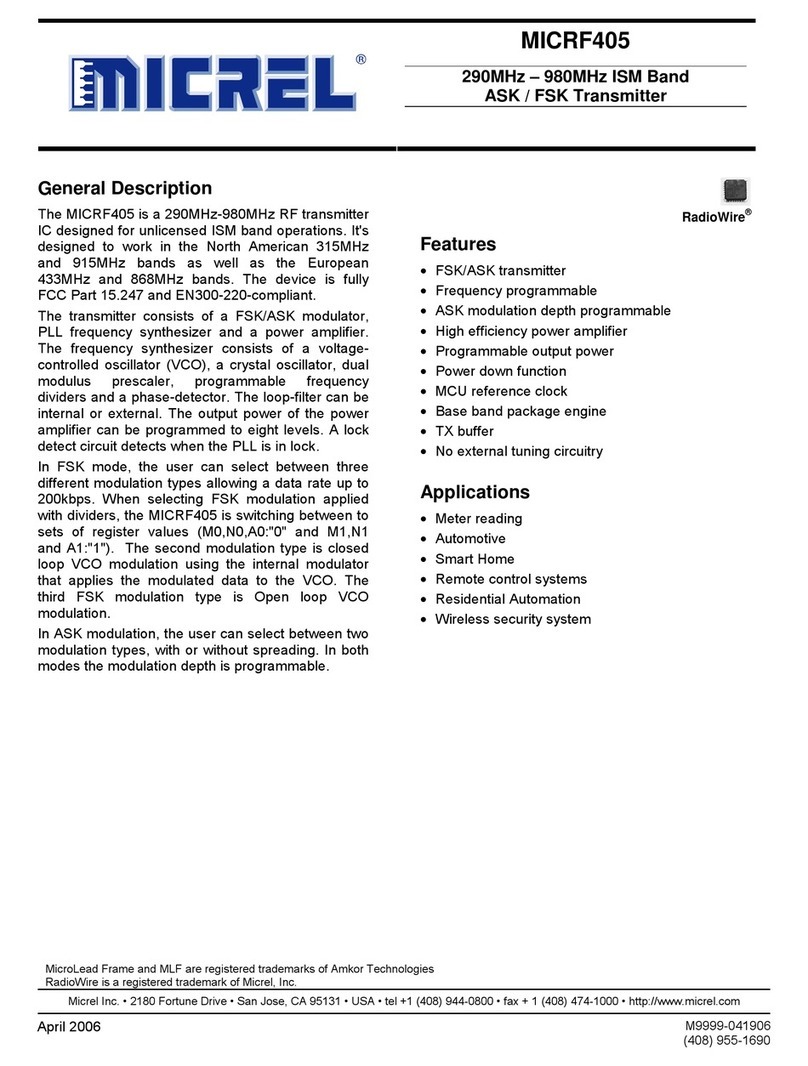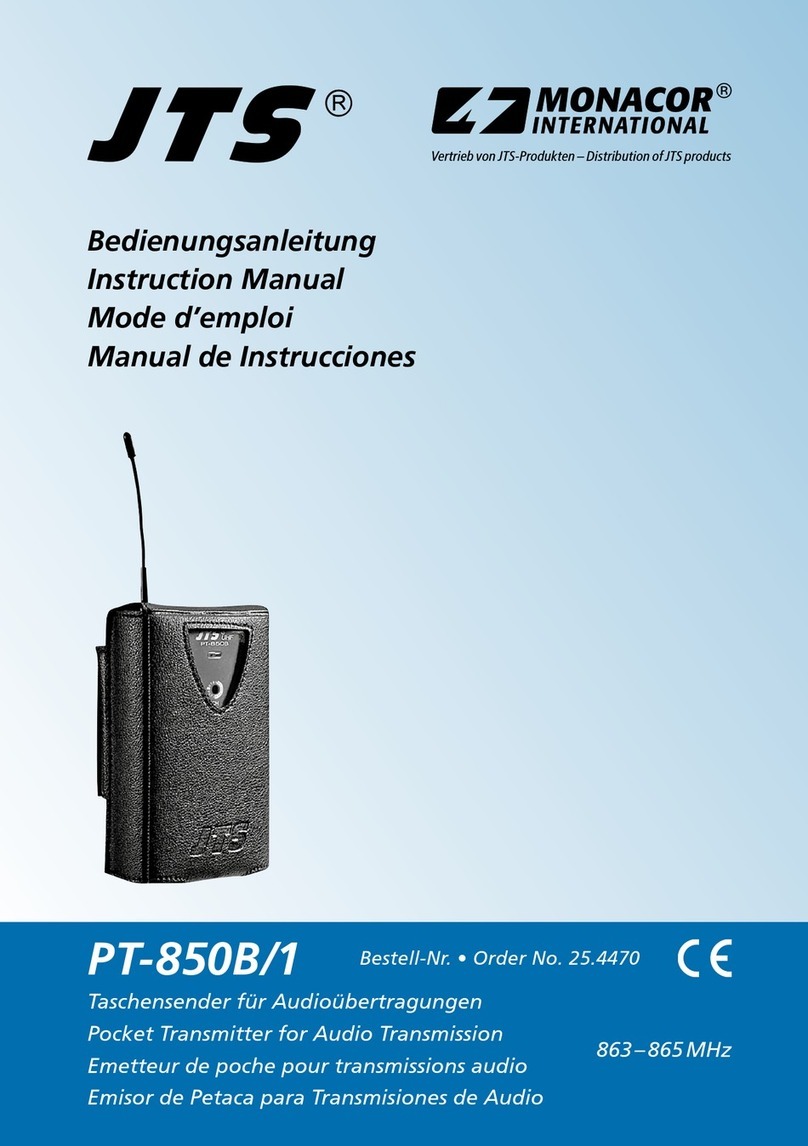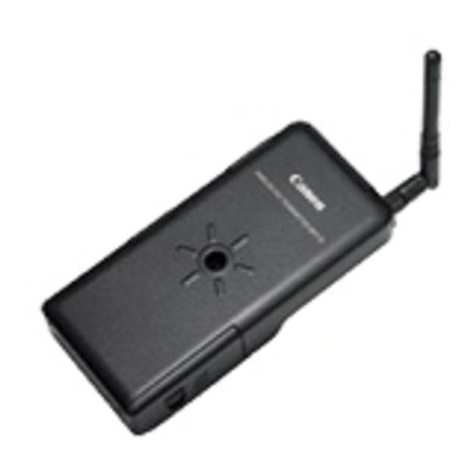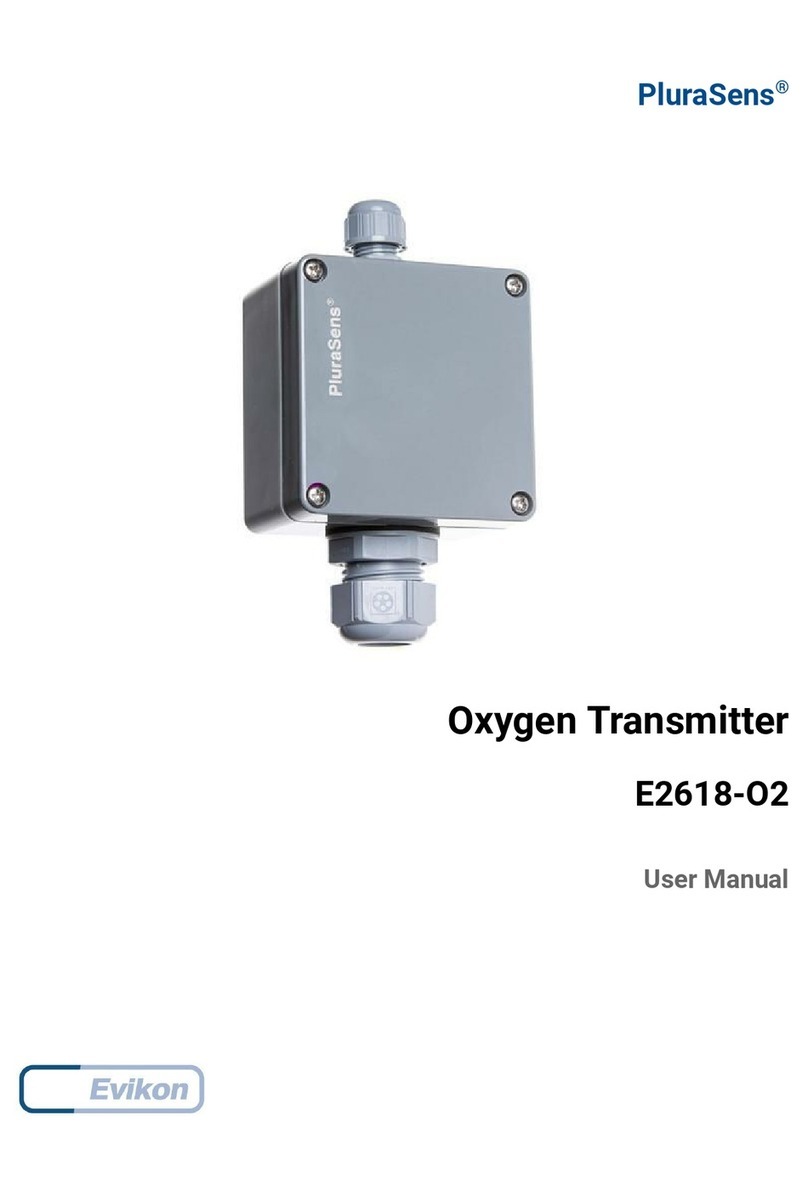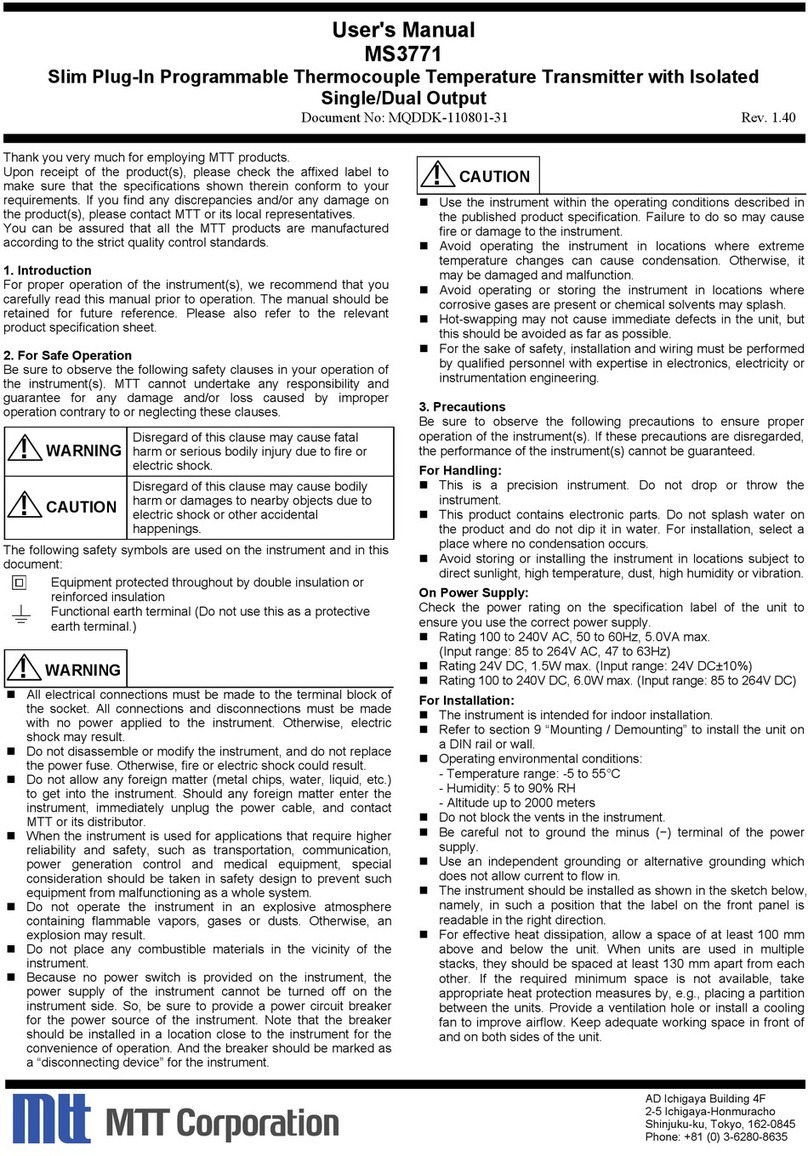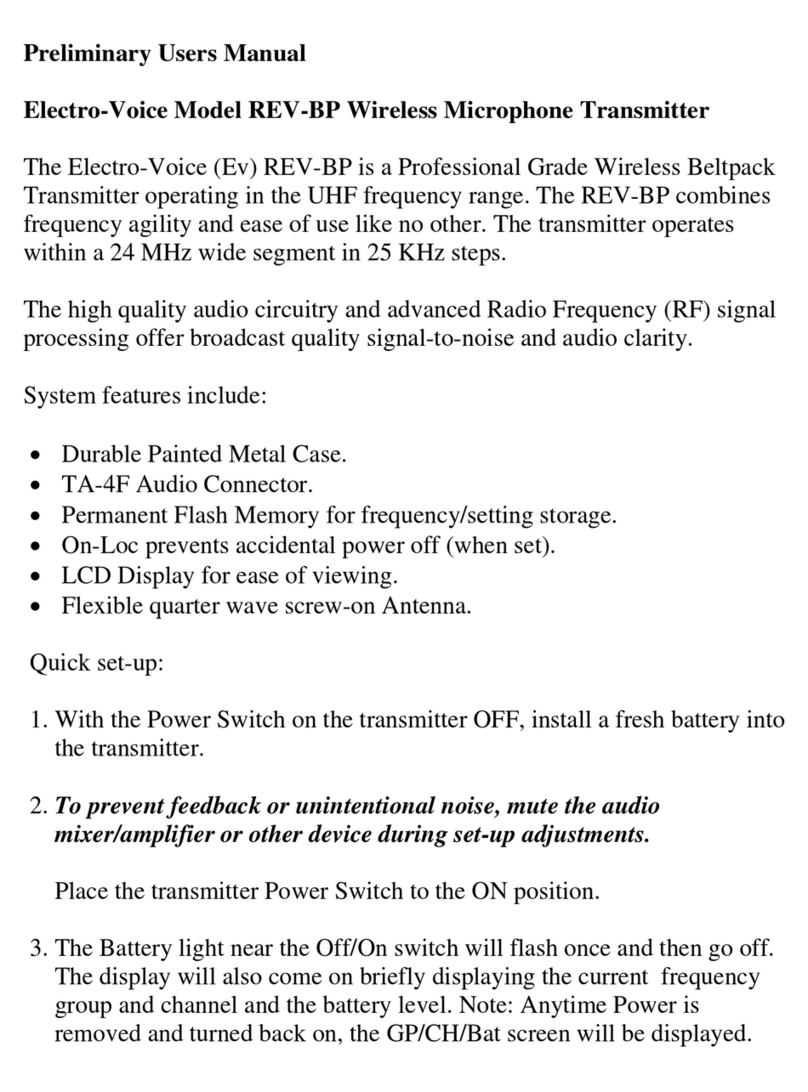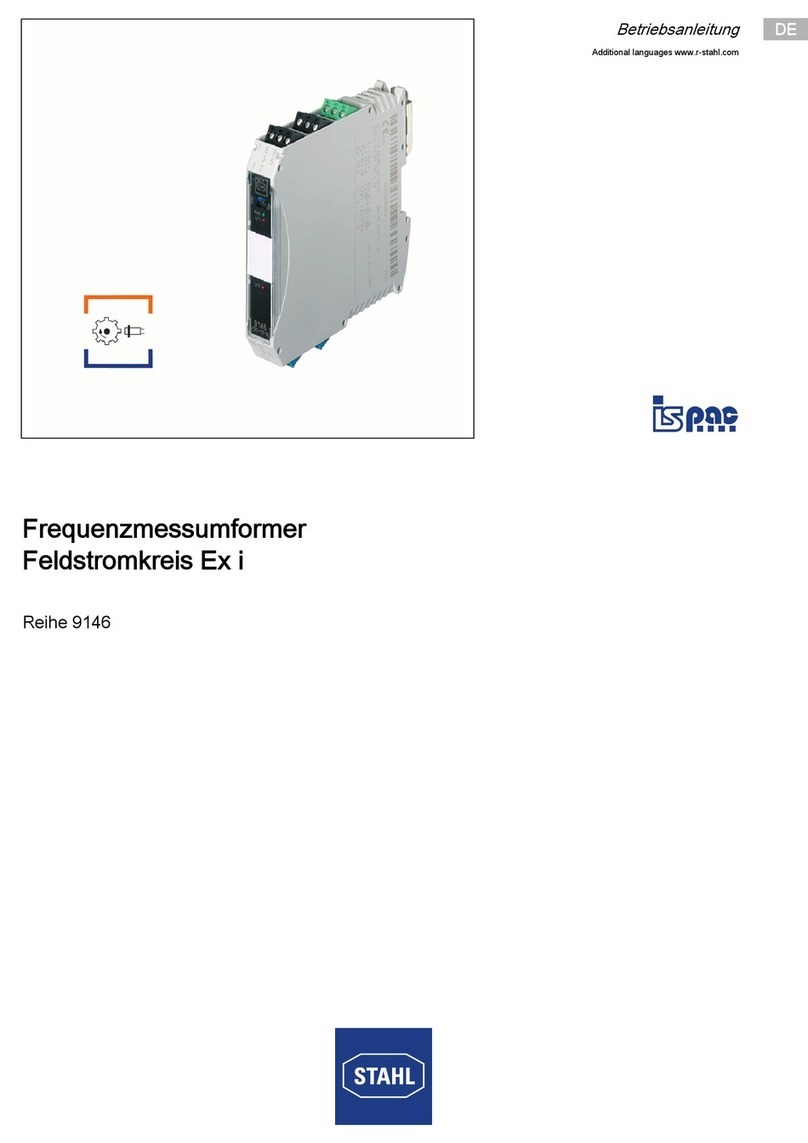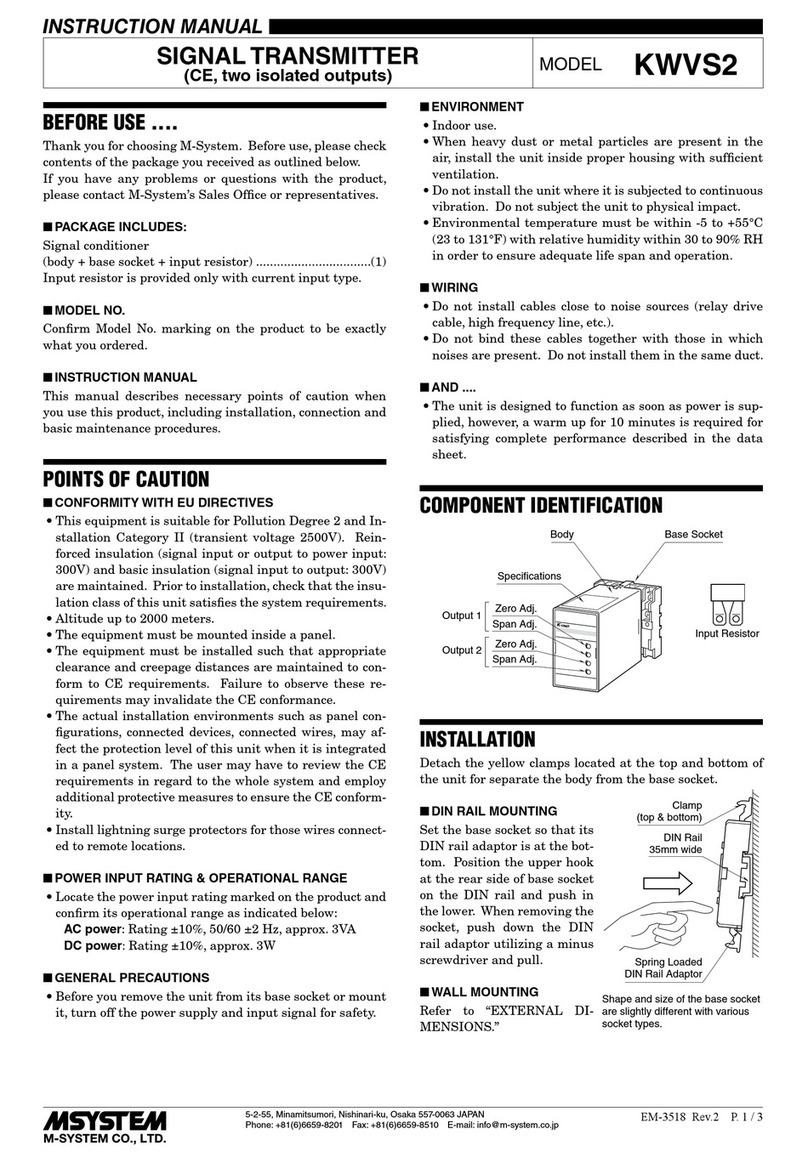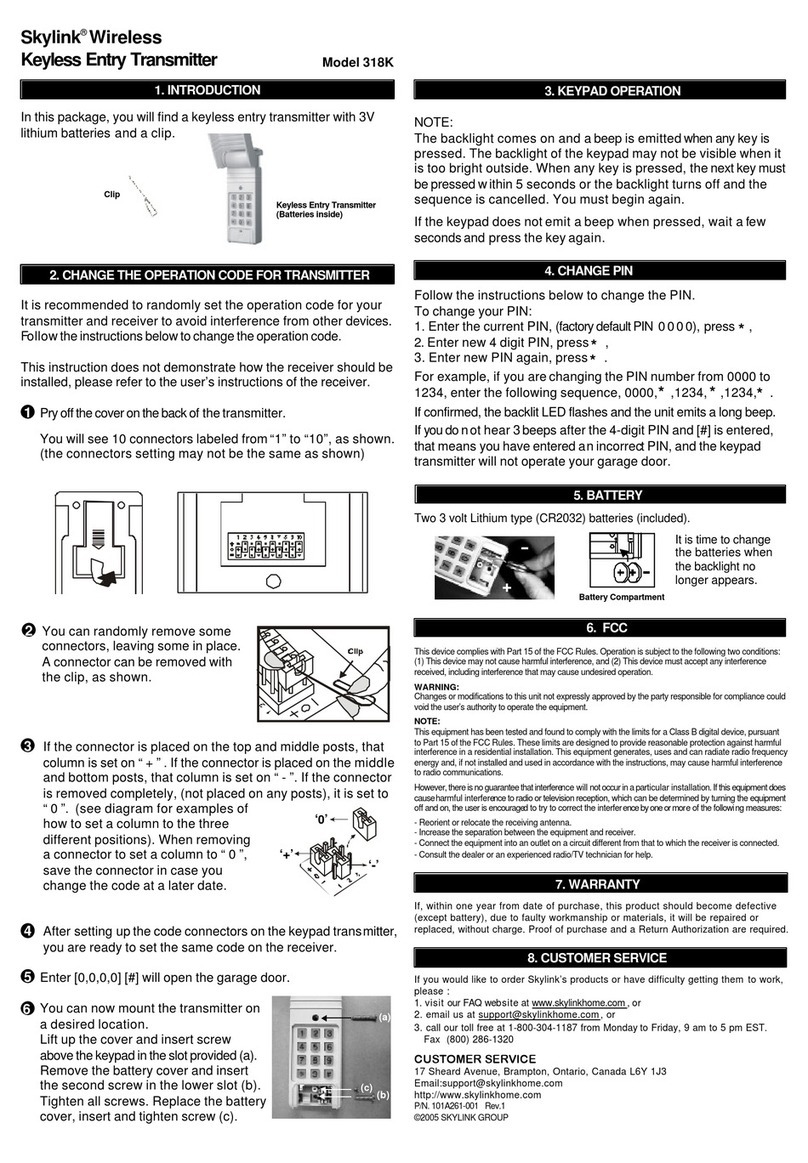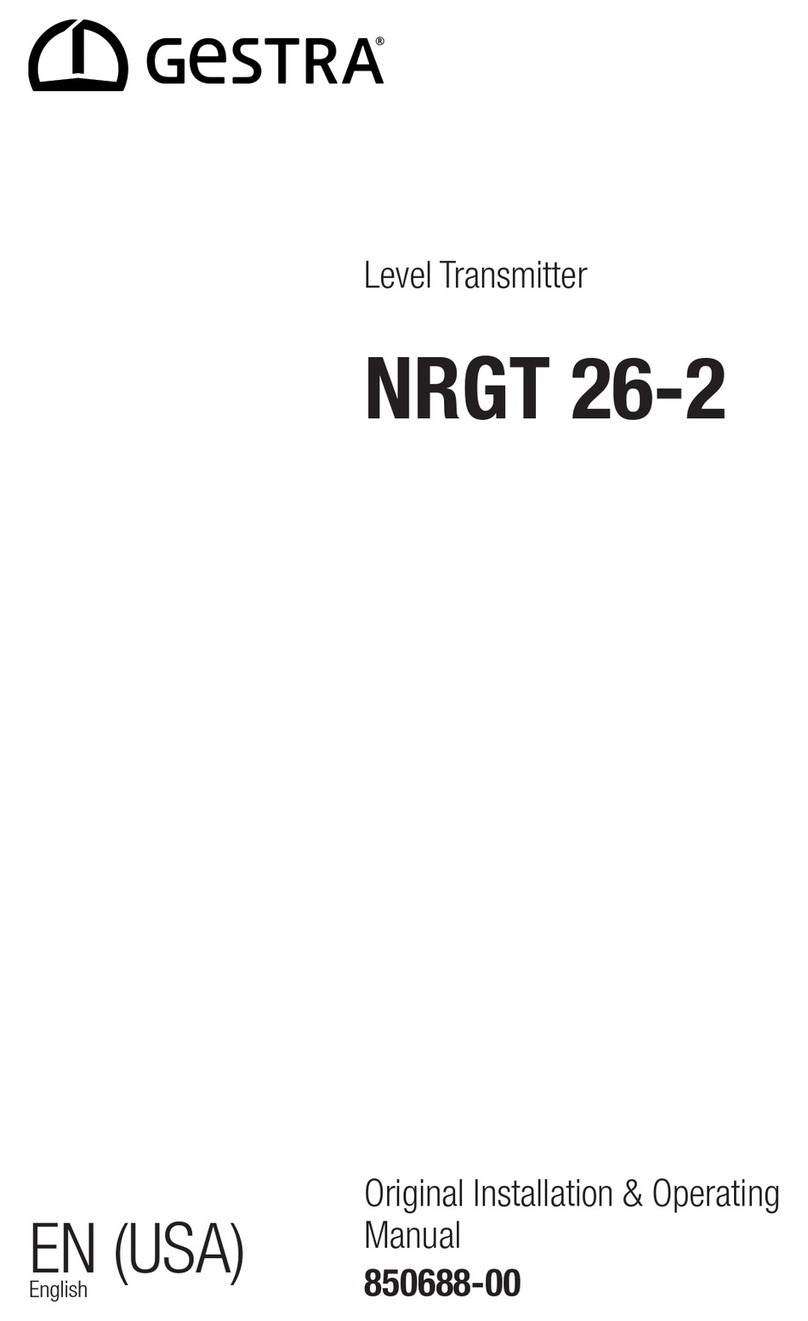Micrel QwikRadio MICRF102 Owner's manual

September 2002 1 MICRF102
MICRF102 Micrel
MICRF102
QwikRadio™ UHF ASK Transmitter
Final Information
General Description
The MICRF102 is a single chip Transmitter IC for remote
wireless applications. The device employs Micrel’s latest
QwikRadio™ technology. This device is a true “data-in,
antenna-out”monolithicdevice. Allantennatuningisaccom-
plished automatically within the IC which eliminates manual
tuning, and reduces production costs. The result is a highly
reliable yet extremely low cost solution for high volume
wireless applications. Because the MICRF102 is a true
single-chip radio transmitter, it is easy to apply, minimizing
design and production costs, and improving time to market.
TheMICRF102usesanovelarchitecturewheretheexternal
loop antenna is tuned to the internal UHF synthesizer. This
transmitteris designedtocomplyworldwideUHFunlicensed
band intentional radiator regulations. The IC is compatible
with virtually all ASK/OOK (Amplitude Shift Keying/On-Off
Keyed)UHFreceiver typesfromwide-bandsuper-regenera-
tive radios to narrow-band, high performance super-hetero-
dyne receivers. The transmitter is designed to work with
transmitter data rates from 100 to 20k bits per second.
Theautomatictuninginconjunctionwiththeexternalresistor,
insures that the transmitter output power stays constant for
the life of the battery.
WhencoupledwithMicrel’sfamilyofQwikRadio™receivers,
the MICRF102 provides the lowest cost and most reliable
remote actuator and RF link system available.
Typical Application
PC
VDD
VSS
REFOSC
ASK
MICRF102
ASK DATA INPUT
RP2
6.8k
0.1µF
4.7µF
RP1
100k
+5V
+5V
Y1
ANTP
ANTM
STBY
LOOP
ANTENNA
(PCB TRACE)
100k
Figure 1
Features
•Complete UHF transmitter on a monolithic chip
•Frequency range 300MHz to 470MHz
•Data rates to 20kbps
•Automatic antenna alignment, no manual adjustment
•Low external part count
•Low standby current <0.04µA
Applications
•Remote Keyless Entry Systems (RKE)
•Remote Fan/Light Control
•Garage Door Opener Transmitters
•Remote Sensor Data Links
Ordering Information
Part Number Temperature Range Package
MICRF102BM –0°C to +85°C 8-Pin SOIC
Micrel, Inc. •1849 Fortune Drive •San Jose, CA 95131 •USA •tel + 1 (408) 944-0800 •fax + 1 (408) 944-0970 •http://www.micrel.com
QwikRadio is a trademark of Micrel, Inc. The QwikRadio ICs were developed under a partnership agreement with AIT of Orlando, Florida

MICRF102 Micrel
MICRF102 2 September 2002
Pin Description
Pin Number Pin Name Pin Function
1 PC Power Control Input. The voltage at this pin should be set between 0.15V to
0.35V for normal operation.
2 VDD Positive power supply input for the IC.
3 VSS This pin is the ground return for the IC. A power supply bypass capacitor
connected from VDD to VSS should have the shortest possible path.
4 REFOSC This is the timing reference frequency which is the transmit frequency
divided by 32. Connect a crystal (mode dependent) between this pin and
VSS, or drive the input with an AC coupled 0.5Vpp input clock. See
Refer-
ence Oscillator
Section in this data sheet
5 STBY Input for transmitter stand by control pin is pulled to VDD for transmit
operation and VSS for stand-by mode.
6 ANTM Negative RF power output to drive the low side of the transmit loop antenna
7 ANTP Positive RF power output to drive the high side of the transmit loop antenna
8 ASK Amplitude Shift Key modulation data input pin. For CW operation, connect
this pin to VDD
Pin Configuration
1PC
VDD
VSS
REFOSC
8 ASK
ANTP
ANTM
STBY
7
6
5
2
3
4
MICRF102BM

September 2002 3 MICRF102
MICRF102 Micrel
Electrical Characteristics
Specifications apply for 4.75V < VDD < 5.5V, VPC = 0.35V, TA= 25°C, freqREFOSC = 12.1875MHz, STBY = VDD. Bold values indicate
0°C ≤TA ≤85°C unless otherwise noted.
Parameter Condition Min Typ Max Units
Power Supply
Standby Supply Current, IQVSTBY < 0.5V, VASK < 0.5V or VASK > VDD –0.5V 0.04 µA
MARK Supply Current, ION @315MHz, Note 4 610.5 mA
@433MHz, Note 4 812 mA
SPACE Supply Current, IOFF @315MHz 4 6mA
@433MHz 6 8.5 mA
Mean Operating Current 33% mark/space ratio at 315MHz, Note 4 4.7 mA
33% mark/space ratio at 433MHz, Note 4 6.7 mA
RF Output Section and Modulation Limits:
Output Power Level, POUT @315MHz; Note 4, Note 5 tbd dBm
@433MHz; Note 4, Note 5 tbd dBm
Transmitted Power @315MHz tbd µV/m
@433MHz tbd µV/m
Harmonics Output, Note 10 @ 315MHz 2nd harm. –46 dBc
3rd harm. –45
@433 MHz 2nd harm. –50 dBc
3rd harm. –41
Extinction Ratio for ASK 40 52 dBc
Varactor Tuning Range Note 7 3 57pF
Reference Oscillator Section
Reference Oscillator Input 300 kΩ
Impedance
Reference Oscillator Source 6µA
Current
Reference Oscillator Input 0.2 0.5 VPP
Voltage (peak to peak)
Absolute Maximum Ratings (Note 1)
Supply Voltage(VDD) .....................................................+6V
Voltage on I/O Pins ............................. VSS–0.3 to VDD+0.3
Storage Temperature Range ..................–65°C to + 150°C
Lead Temperature (soldering, 10 seconds) ...........+ 300°C
ESD Rating .............................................................. Note 3
Operating Ratings (Note 2)
Supply Voltage (VDD) .................................... 4.75V to 5.5V
Maximum Supply Ripple Voltage ...............................10mV
PC Input Range..............................150mV < VPC < 350mV
Ambient Operating Temperature (TA) ............0°C to +85°C
Programmable Transmitter Frequency Range:
.................................................... 300MHz to 470MHz

MICRF102 Micrel
MICRF102 4 September 2002
Parameter Condition Min Typ Max Unit
Digital / Control Section
Calibration Time Note 8, ASK=HIGH 25 ms
Power Amplifier Output Hold Off Note 9, STDBY transition from LOW to HIGH 6 ms
Time from STBY Crystal, ESR < 20Ω
Transmitter Stabilization Time From External Reference (500mVpp) 10 ms
from STBY Crystal, ESR < 20Ω19 ms
Maximum Data Rate
–ASK modulation Duty cycle of the modulating signal = 50% 20 kbits/s
VSTBY Enable voltage 0.75VDD 0.6VDD V
STBY Sink Current ISTBY = VDD 56.5 µA
ASK pin VIH, input high voltage 0.75VDD 0.6VDD V
VIL, input low voltage 0.3VDD 0.25VDD V
ASK input current ASK = 0V, 5.0V input current –10 0.1 10 µA
Note 1. Exceeding the absolute maximum rating may damage the device.
Note 2. The device is not guaranteed to function outside its operating rating.
Note 3. Devices are ESD sensitive. Handling precautions recommended. Human body model, 1.5k in series with 100pF.
Note 4. Supply current and output power are a function of the voltage input on the PC (power control) pin. All specifications in the Electrical Charac-
teristics table applies for condition VPC = 350mV. Increasing the voltage on the PC pin will increase transmit power and also increase MARK
supply current. Refer to the graphs "Output Power Versus PC Pin Voltage" and "Mark Current Versus PC Pin Voltage."
Note 5. Output power specified into a 50Ωequivalent load using the test circuit in Figure 5.
Note 6. Transmitted power measured 3 meters from the antenna using transmitter board TX102-2A in Figure 6.
Note 7. The Varactor capacitance tuning range indicates the allowable external antenna component variation to maintain tune over normal production
tolerances of external components. Guaranteed by design not tested in production.
Note 8. When the device is first powered up or it loses power momentarily, it goes into the calibration mode to tune up the transmit antenna.
Note 9. After the release of the STDBY, the device requires an initialization time to settle the REFOSC and the internal PLL. The first MARK state
(ASK HIGH) after exit from STDBY needs to be longer than the initialization time. The subsequent low to high transitions will be treated as
data modulation whereby the envelope transition time will apply.
Note 10. The MICRF102 was tested to be Compliant to Part 15.231 for maximum allowable TX power, when operated in accordance with a loop
antenna described in Figure 6.

September 2002 5 MICRF102
MICRF102 Micrel
Typical Characteristics
0
5
10
15
20
25
0 100 200 300 400 500 600
CURRENT (mA)
V
PC
(mV)
Mark Current vs
PC Pin Volta
g
e
-35
-30
-25
-20
-15
-10
-5
0
5
0 100 200 300 400 500 600
OUTPUT POWER (dBm)
VPC (mV)
Output Power vs
PC Pin Volta
g
e

MICRF102 Micrel
MICRF102 6 September 2002
Functional Description
The block diagram illustrates the basic structure of the
MICRF102. Identifiedinthefigurearetheprincipalfunctional
blocks of the IC, namely the (1, 2, 3, 4, 5) UHF Synthesizer,
(6a/b) Buffer, (7) Antenna tuner, (8) Power amplifier, (9) TX
bias control, (10) Reference bias and (11) Process tuner.
The UHF synthesizer generates the carrier frequency with
quadrature outputs. The in-phase signal (I) is used to drive
the PA and the quadrature signal (Q) is used to compare the
antenna signal phase for antenna tuning purpose.
The Antenna tuner block senses the phase of the transmit
signalat theantennaportandcontrolsthevaractor capacitor
to tune the antenna.
The Power control unit senses the antenna signal and con-
trolsthePA bias current toregulate the antennasignal to the
transmit power.
Functional Diagram
TX
Bias
Control
Varactor
Device
Antenna
Tuning
Control
Power
Amp
Buffer
VSS
ANTM
ANTP
ASK
Buffer
Prescaler
Divide
by 32
REF.OSC
PC
VDD
VDD (10)
(5)
(2)
Reference
Oscillator (1)
VCO (4)
(3)
(9) (8)
(7)
(11)
(6a)
(6b)
STBY Reference
Bias
Phase
Detector
Figure 2. MICRF102 Block Diagram
The Process tune circuit generates process independent
bias currents for different blocks.
A PCB antenna loop coupled with a resonator and a resistor
divider network are all the components required to construct
acompleteUHFtransmitterforremoteactuationapplications
such as automotive keyless entry.
Included within the IC is a differential varactor that serves as
the tuning element to insure that the transmit frequency and
antenna are aligned with the receiver over all supply and
temperature variations.

September 2002 7 MICRF102
MICRF102 Micrel
Applications Information
Design Process
The MICRF102 transmitter design process is as follows:
1). Set the transmit frequency by providing the
correct reference oscillator frequency
2). Ensure antenna resonance at the transmit
frequency by:
LANT = 0.2 ×Length ×ln(Length/d - 1.6) ×10-9 ×k
Where:
Length is the total antenna length in mm.
d is the trace width in mm.
k is a frequency correction factor.
LANT is the approximate antenna inductance in
henries.
Note 1. The total inductance however will be a little greater
than the LANT calculated due to parasitics. A 2nH should be
added to the calculated value. The LANT formula is an
approximatedwaytocalculatetheinductanceoftheantenna.
The inductance value will vary however, depending on pcb
material,thickness,groundplane,etc.Themostpreciseway
to measure is to use a RF network analyzer.
3). Calculate the total capacitance using the follow-
ing equation.
CfL
TANT
=×××
()
1
422
ππ
Where:
CTtotal capacitance in farads.
π= 3.1416.
f = carrier frequency in hertz.
LANT inductance of the antenna in henries.
4). Calculate the parallel and series capacitors,
which will resonate the antenna.
4.1). Ideally for the MICRF102 the series and parallel
capacitors should have the same value or as
close as possible.
4.2). Start with a parallel capacitor value and plug in
the following equation.
C
CC C
S
T VAR P
=−+
()
1
11
Where:
CVAR is the center varactor capacitance (5pF for the
MICRF102) in farads.
CPis the parallel capacitor in farads.
CSis the series capacitor in farads.
Repeat this calculation until CSand CPare very close and
they can be found as regular 5% commercial values.
Note2.Ideally,theantennasizeshouldnotbelargerthanthe
oneshownhere. Thebiggertheantennaarea, thehigherthe
loaded Q in the antenna circuit will be. This will make more
difficult to match the parallel and series capacitors. Another
point to take into consideration is the total ac rms current
going through the internal varactor in the MICRF102. This
current should not exceed 16mA rms. The parallel capacitor
will absorb part of this current if the antenna dimensions are
appropriate and not exaggerated larger than the one shown
here.
Note 3. A strong indication that the right capacitor values
havebeenselected is the meancurrent with a1kHz signal in
the ASK pin. Refer to the
Electrical Characteristics
for the
current values.
Note4.Formuch smaller antennas, placeablockingcapaci-
tor for the series capacitance (around 100pF to 220pF) and
usethefollowingformulafortheparallelcapacitanceCT=CP
+ CVAR. The blocking capacitor is needed to ensure that no
dc current flows from one antenna pin to the other.
5.) Set PC pin to the desired transmit power.
Reference Oscillator Selection
Anexternalreferenceoscillatorisrequiredtosetthetransmit
frequency. The transmit frequency will be 32 times the
reference oscillator frequency.
ff
TX REFOSC
=×32
Crystalsorasignalgeneratorcanbeused.Correctreference
oscillator selection is critical to ensure operation. Crystals
must be selected with an ESR of 20 Ohms or less. If a signal
generator is used, the input amplitude must be greater than
200 mVP-P and less than 500 mVP-P.
Antenna Considerations
The MICRF102 is designed specifically to drive a loop an-
tenna. It has a differential output designed to drive an induc-
tive load. The output stage of the MICRF102 includes a
varactor that is automatically tuned to the inductance of the
antenna to ensure resonance at the transmit frequency.
A high-Q loop antenna should be accurately designed to set
the center frequency of the resonant circuit at the desired
transmitfrequency.Anydeviationfromthedesiredfrequency
will reduce the transmitted power. The loop itself is an
inductive element. The inductance of a typical PCB-trace
antennaisdeterminedbythesizeoftheloop,thewidthofthe
antenna traces, PCB thickness and location of the ground
plane.Thetoleranceoftheinductanceissetbythemanufac-
turing tolerances and will vary depending how the PCB is
manufactured.
The MICRF102 features automatic tuning. The MICRF102
automaticallytunesitselftotheantenna,eradicatingtheneed
formanualtuningin production. Italsodynamicallyadaptsto
changesinimpedance inoperationandcompensates forthe
hand-effect.
Automatic Antenna Tuning
The output stage of the MICRF102 consists of a variable
capacitor (varactor) with a nominal value of 5.0pF tunable
over a range from 3pF to 7pF. The MICRF102 monitors the
phase of the signal on the output of the power amplifier and
automaticallytunestheresonantcircuitbysettingthevaractor
value at the correct capacitance to achieve resonance.

MICRF102 Micrel
MICRF102 8 September 2002
In the simplest implementation, the inductance of the loop
antenna should be chosen such that the nominal value is
resonantat5pF,thenominalmid-rangevalueoftheMICRF102
output stage varactor.
Using the equation:
LfC
=1
4
22
ππ
Ifthe inductanceoftheantennacannot besetatthenominal
value determined by the above equation, a capacitor can be
added in parallel or series with the antenna. In this case, the
varactor internal to the MICRF102 acts to trim the total
capacitance value.
L
ANTENNA
C
VARACTOR
C
P
C
S
Figure 4.
Supply Bypassing
Correct supply bypassing is essential. A 4.7uF capacitor in
parallel with a 100pF capacitor is recommended.
The MICRF102 is susceptible to supply-line ripple, if supply
regulation is poor or bypassing is inadequate, spurs will be
evident in the transmit spectrum.
PC
VDD
VSS
REFOSC
ASK
MICRF102
L
ASK DATA INPUT Transformer Output to 50‰
Impedance Transformation
Network
OFF
ON
RP2
(6.8k)
RP1
(100k)
+5V
Crystal
Z1 Z3
Z2
ANTP
ANTM
STBY
To 50‰
Termination of
Spectrum Analyzer
Figure 5. Application Test Circuit For Specification Verification
Transmit Power
The transmit power specified in this datasheet is normalized
to a 50Ohm load. The antenna efficiency will determine the
actual radiated power. Good antenna design will yield trans-
mitpowerintherangeof67dBµV/mto80dBµV/mat3meters.
The PC pin on the MICRF102 is used to set the transmit
power.ThedifferentialvoltageontheoutputofthePA(power
amplifier) is proportional to the voltage at the PC pin.
With more than 0.35V on the PC pin the output amplifier
becomes current limited. At this point, further increase in the
PC pin voltage will not increase the RF output power in the
antenna pins. Low power consumption is achieved by de-
creasing the voltage in the PC pin, also reducing the RF
output power and maximum range.
Output Blanking
Whenthedeviceisfirstpowereduporafteramomentaryloss
of power the output is automatically blanked (disabled). This
feature ensures RF transmission only occurs under con-
trolled conditions when the synthesizer is fully operational,
preventing unintentional transmission at an undesired fre-
quency. Output blanking is key to guaranteeing compliance
withUHFregulationsbyensuringtransmissiononlyoccursin
the intended frequency band.

September 2002 9 MICRF102
MICRF102 Micrel
Design Examples
Complete reference designs including gerber files can be
downloaded from Micrel’s website at www.micrel.com/prod-
uct-info/qwikradio.shtml.
Antenna Characteristics
In this design, the desired loop inductance value is deter-
mined according to the table below.
Freq. R XL Ind Q K
(MHz) (ohms) (ohms) (nH) (XL/R)
300 1.7 84.5 44.8 39.72 0.83
315 2.34 89.3 45.1 39.65 0.85
390 3.2 161 47.4 52.00 0.90
434 2.1 136 50.0 78.33 0.96
The reference design shown in Figure 6. has an antenna
meeting this requirement.
Figure 6
Loopantennasareoftenconsideredhighlydirectional.Infact
small loop antennas can achieve transmit patterns close in
performance to a Dipole antenna. The radiation pattern
below is the theoretical radiation pattern for the antenna
shown in Figure 6.
E-total, phi = 0¡
E-total, phi = 90¡
(180-phi) direction phi direction
30.0
180.0
60.0
120.0
150.0
150.0
120.0
60.0
30.0 0.0
Figure 7. Polar Elevation pattern at 315MHz
The 0 degree plot is the radiation pattern in the plane of the
transmitter PCB, the 90 degree plot represents the plane
perpendicular to the PCB. Micrel’s evaluation of the perfor-
mance of the board in Figure 6. indicates an even more
uniformradiationpatternthatthetheoreticalplotshownhere.
Supply Bypassing
Supply bypassing consists of three capacitors; C3 = 4.7uF,
C4 = 0.1uFand C5 = 100pF
C4
0.1 F
16V
C5
100pF
50V
C3
4.7 F
16V
+5VTX
VDD
V
SS
MICRF102BM
2
3
PC1ASK 8
ANTP 7
ANTM 6
SB 5REFOSC4
Figure 8.
Example to Calculate CS and CP
Antenna Inductance Calculation
Length_mils = 2815
dmils = 70
k = 0.85
Length Length_mils 25.4
1000
Length 71.501
=×
()
=
ddmils
d
=×
()
=
25 4
1000
1 778
.
.
L 0.2 Length ln Length
d1.6 10 k
L4410
9
9
=× × −
××
=×
−
−
Where Length and d are in mm and L is in H;
Where k is a constant dependent on pcb material, copper
thickness, etc
MICRF102 Series Capacitor Calculation
f = 315 ×106
L = 46 ×10-9
CVAR = 5 ×10-12
CP= 12 ×10-12
ClfL
C
T
T
=×××
=×
−
4
555 10
22
12
ππ
.
C
CC
C
SERIES
T VAR
SERIES
=−
=×
−
1
11
82 1012
.

MICRF102 Micrel
MICRF102 10 September 2002
MICRF102 Series Capacitor Calculation
f = 433.92 ×106
L = 52 ×10-9
CVAR = 5 ×10-12
CP= 2.7 ×10-12
CfL
C
T
T
=×××
=×
−
1
4
2 587 10
22
12
ππ
.
C
CC C
C
SERIES
T VAR P
SERIES
=−+
=×
−
1
11
39 1012
.
L1 = 52 ×10-9
f1 = 433.92 ¥106
CfL
C
T
T
122
112
1
41
2 587 10
=×××
=×
−
ππ
.

September 2002 11 MICRF102
MICRF102 Micrel
Package Information
45°3°–6°
0.244 (6.20)
0.228 (5.80)
0.197 (5.0)
0.189 (4.8)
0.063 (1.60) MAX
SEATING
PLANE
0.026 (0.65)
MAX)
0.016 (0.40)
TYP
0.154 (3.90)
0.057 (1.45)
0.049 (1.25)
0.193 (4.90)
0.050 (1.27)
TYP
PIN 1
DIMENSIONS:
INCHES (MM)
8-Pin SOP (M)

MICRF102 Micrel
MICRF102 12 September 2002
MICREL, INC. 1849 FORTUNE DRIVE SAN JOSE, CA 95131 USA
TEL + 1 (408) 944-0800 FAX + 1 (408) 944-0970 WEB http://www.micrel.com
This information is believed to be accurate and reliable, however no responsibility is assumed by Micrel for its use nor for any infringement of patents or
other rights of third parties resulting from its use. No license is granted by implication or otherwise under any patent or patent right of Micrel, Inc.
© 2002 Micrel, Incorporated
Table of contents
Other Micrel Transmitter manuals
